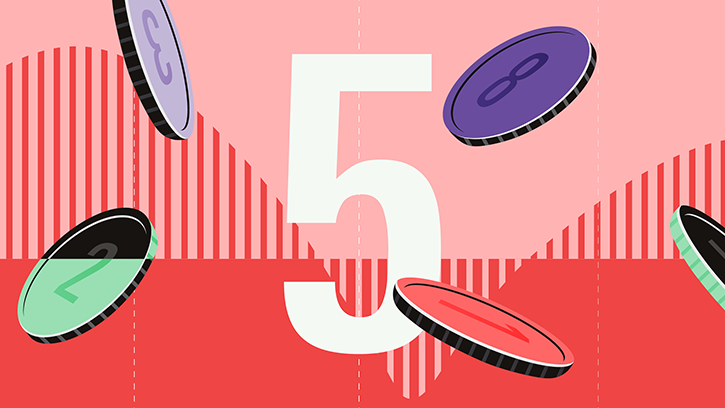
The price/earnings ratio is one of the most commonly used measures in equity investing. But what is it and how can it help you? Here's everything you need to know.
1. P/E tells what the market is willing to pay for each monetary unit of the company's profits
The lower the P/E, the lower the entrance fee to take part in the company's profits. For example, if the share costs £10 and the earnings per share is £1, the P/E = 10/1 = 10. This means that the market is now willing to pay 10 times as much as the company's profits. If the same share at a later date costs £12 and the earnings per share are unchanged, P/E = 12/1 = 12.
2. P/E can give a clue as to whether a stock is cheap or expensive
Although there is no concrete number that constitutes a "low" or "high" P/E, it can nevertheless generally be said that a low P/E is typically below 15 and a high P/E is typically above 30.
Low P/E can mean the share is attractively priced, but it can also mean the company has fundamental problems and may be a value trap. Value stocks tend to have relatively low P/E (for example, Morningstar Developed Markets Europe Financial Services Sector Index currently has a P/E of 11.3 and trades relatively cheaply).
A high P/E, meanwhile, can mean the stock is overpriced. Alternatively, it may indicate that the market expects great growth potential in the company in the future, and that P is high because E is expected to rise in the future. Growth stocks tend to have a relatively high P/E (for example, the Morningstar Developed Markets Europe Technology Sector Index currently has a P/E of 37.1, a possible indication that this sector is overpriced, at least compared to historical levels).
3. P/E can tell how many years it will take before the profit covers the price paid for the share
A P/E of 10 means it will take 10 years before the accumulated earnings per share match what was paid for the share. A P/E of 30 means that the repayment will take 30 years. In other words, the higher the P/E a share had at the time of purchase, the greyer the investor's hair will be before the share has covered the purchase price (assuming unchanged conditions).
4. The inverse of P/E gives the profit margin (E/P)
The profit margin means the profit as a percentage of the share price. A share price of £20 and an earnings per share of £1 indicate a profit margin of 5% (E/P = 1/20 = 5%). The profit margin can be set against the returns on other investment opportunities, such as corporate bonds. If the profit margin of the stock is approximately equal to the return on the bond, and you do not expect the company to grow, does the share purchase provide a satisfactory risk-reward or should you aim your binoculars for a fatter dairy cow?
5. There are two types of P/E: historical and future-oriented
Historical P/E is usually based on earnings during the last 12 months (TTM = trailing twelve months). The challenge with historical P/E is that it doesn't tell us what will happen in th future - and there is no guarantee that the historical trend will continue. A future-oriented P/E, then, takes into account estimated profits for the next four quarters. (P is the same in both variants, however: current share price).
6. P/E should only be compared with something relevant
P/E gives a snapshot in time, but in isolation does not provide particularly useful information. It is only when P/E is used relative to something else that you get valuable information. If, for example, a house costs £500,000, is it cheap or expensive? To be able to answer that question you need relevant reference points: it's previous sale price, what condition it is in, what is the price per square metre in relation to a comparable house nearby? The same applies to P/E.
What can you compare P/E to?
- It's own history - is the ratio higher or lower than it used to be?
- It's peers - what is the P/E of other companies in the same sector?
- The market - what is the average P/E on the stock market on which the share is listed?
7. P/E can be aggregated
P/E can be aggregated up to, for example, fund/category/index level. THis helps you compare a fund's P/E against the average fund in its category or its benchmarket index. THis can give you a better insight into the fund's investment strategy.
8. P/E has limitations
P/E is not perfect and it's not a one-stop shop for investors, so it should be used only as one metric in your wider toolbox.
The E of P/E (earnings), as previously mentioned, is often based on historical figures, while the share price looks ahead. That's a problem because future E may be difficult to estimate, especially for growth companies. Moreover, if E is negative or equal to zero, P/E is basically useless - again that's an issue for growth companies that may not yet be profitable.
E is an accounting figure that can be affected by subjective interpretations. For example, depreciation: Lower depreciation results in lower expenses, which results in higher profits and higher E = lower P/E. Or vice versa.
Extraordinary events may also have an impact. For example, consider a company selling equipment: profits rise in the current financial year meaning E increases and the P/E decreases. But revenues drop the follow year, so E decreases and the P/E increases.
Share buybacks may also skew the data: a share repurchase reduces the number of shares in issue while earnings remain the same, meaning earnings per share goes up, increase E and decreasing P/E.





























